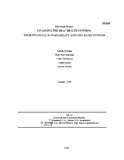| dc.contributor.author | Khan, Suhaila H | |
| dc.contributor.author | Mahmud, Shah Noor | |
| dc.contributor.author | Karim, Fazlul | |
| dc.contributor.author | Afsana, Kaosar | |
| dc.date.accessioned | 2020-01-16T03:54:13Z | |
| dc.date.available | 2020-01-16T03:54:13Z | |
| dc.date.issued | 1998-01 | |
| dc.identifier.citation | Khan, S. H., Mahmud, S. N., Chowdhury, A., Karim, F., & Afsana, K. (1998, January). Financing the BRAC Health Centres: their financial sustainability and cost-effectiveness. Research Reports (1997): Health Studies, Vol - XXI, 233–256. | en_US |
| dc.identifier.uri | http://hdl.handle.net/10361/13568 | |
| dc.description.abstract | The Health ana Population Division (HPO) of BRAC aims to provide supportive secondary level health
care services for the community through the BRAC Health Centres (BHCs) or Shushasthyos. The
BHCs began operating in HPO areas in 1995. As of January 1998 there were 27 BHCs. All BHCs
function through user fees in order to make the BHCs financially sustainable in the long run. HPD is
endeavoring strategic planning in order to reduce donor dependence and meet the projected resource
gaps through the implementation of certain systems such as, cost recovery and cost sharing through
the BHCs, to ensure financial sustainability in the long run. The Research and Evaluation Division
(RED) of BRAC aimed to evaluate how much cost recovery was occurring at the BHCs which
contributed to BHCs' financially sustainability, and what modifications need consideration to support
enhance this sustainability. This was a health facility based study done in 9 BHCs in three
regions. Mymensingh, Bogra and Dinajpur. The variables considered for this study were related to
cost. revenue, cost sharing and effects.
The average or unit cost of operating a BHC was Tk. 422.092. The recurrent cost was Tk.
403 ,547 and capital cost was Tk. 18,545. Average income per BHC was Tk. 89,631. The cost
recovery was 22% of recurrent costs and 21% of total costs. And if we considered the variables
similar to HPD then cost recovery was 35% of recurrent costs and 33% of total costs. 23% of
the indicators mentioned in the monthly disease profile cover gynaecologicals conditions.
These constitute about 11% of the total general diseases being identified and/or treated at the
BHCs. This is only possible due to having a facility such as a BHC. The unit cost per patient
visit was Tk. 93. Some interventions, such as ANC and GM done at BHCs seemed to be
cheaper compared to previous findings of WHOP and RDP-PHC. | en_US |
| dc.language.iso | en | en_US |
| dc.publisher | BRAC Research and Evaluation Division (RED) | en_US |
| dc.subject | BRAC | en_US |
| dc.subject | BRAC Health Centres | en_US |
| dc.subject | Financial sustainability | en_US |
| dc.subject | Cost-effectiveness | en_US |
| dc.subject.lcsh | Ambulatory medical care -- Bangladesh -- Cost effectiveness. | |
| dc.subject.lcsh | Community Health Centers -- organization & administration. | |
| dc.title | Financing the BRAC Health Centres: their financial sustainability and cost-effectiveness | en_US |
| dc.type | Research report | en_US |

